In the wild, stunning landscapes of Alaska, a unique array of wildlife has found a home. Among these captivating creatures, the hawks hold a special place. Tens of thousands of hawks in Alaska are not just mere birds; they are symbols of power, incredible eyesight, agility, and natural beauty, quietly ruling the sky.
In this guide, we’ll explore the intriguing world of these formidable birds of prey, their types, behaviors, and the role they play in Alaska’s thriving ecosystem. So, get ready for an exhilarating journey into the fascinating realm of Alaskan hawks.
Lists of Hawks in Alaska:
Northern Goshawk: Known to frequent the coniferous forests, these elusive northern goshawk can often be spotted in the Tongass National Forest.
Red-Tailed Hawk: Favored by open landscapes, these red tailed hawk length can often be seen soaring above the valleys of the Denali National Park.
Rough-legged Hawk: During the summer, these birds migrate to the tundra regions of Alaska. Check out the Arctic National Wildlife Refuge for a chance to spot them.
Sharp-Shinned Hawk: These agile sharp shinned hawks prefer the dense woodland areas and are often seen in the Chugach State Park.
Northern Harrier: With a preference for marshy areas, these northern harriers are commonly spotted in the Minto Flats State Game Refuge.
Swainson’s Hawk: Known for its long migration, this species can be seen during its passage through the Wrangell-St. Elias National Park.
Osprey: Lovers of bodies of water, these fish-eating hawks can often be seen near the rivers and lakes in the Kenai Fjords National Park.
Northern Goshawk (Accipiter gentilis)


Listen:
The Northern Goshawk is a medium-sized hawk that is found in North America, Europe and Asia. It has brown eyes, a large sharp beak, and dark brown plumage on its upperparts and head, with white underparts that are spotted with brown barring. Its tail feathers are grayish-black with a dark band near the tip.
Northern goshawks eat squirrels, rabbits, grouse, woodchucks and other small mammals like voles or mice (which they often eat whole). They will also take larger prey such as deer fawns or even adult deer if they have no other choice. They have broad wings with long feathers that allow them to glide through the air when they catch their prey. They also have an excellent sense of smell which helps them locate their food source.
The Northern Goshawk builds its nest in a tree cavity or on a ledge, usually on the edge of an open area so it can easily see prey below. The female lays 3 to 5 eggs over two days and incubates them for 28 to 30 days while the male brings food to her every few hours until they hatch. The young fledge after about 6 weeks and leave the nest when they are about 10 weeks old.
Red-tailed Hawk (Buteo jamaicensis)

The Red-tailed Hawk is a large bird of prey that is commonly found across North America. This species is part of the genus Buteo, which is often referred to as the “true hawks,” and includes more than two dozen species of raptors.
Red-tailed Hawks have a robust size, ranging from 18 to 26 inches in length and sporting a wingspan that can exceed 4 feet. They have a broad, rounded set of wings and a short, wide red tail. This species is most easily recognized by its rich, rust-colored tail, which gives it its common name. However, juvenile hawks might not yet have this distinctive feature.
Their feathers are generally dark brown on their dorsal side (back) with a lighter, often speckled, ventral side (front). The intensity and pattern of their plumage can vary significantly based on their age and geographic location, as there are about 14 recognized subspecies of Red-tailed Hawks.
As for their diet, Red-tailed Hawks are carnivores and have a broad diet that includes rodents, ground rabbits, reptiles, and other birds. They are skilled hunters that typically sit on high perches and use their keen eyesight to spot potential prey. Once they have identified a target, they swoop down to capture it with their powerful talons.
Red-tailed Hawks mate for life and build nests high off the ground, often in tall trees or on cliff edges. Their nests are made of sticks and can be quite large. They typically lay 1-3 eggs per year, which are incubated by both parents.
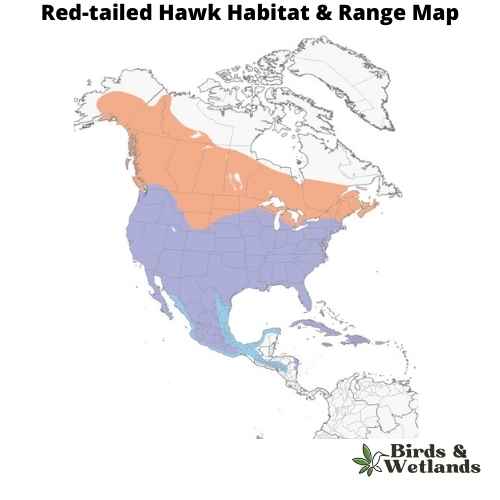
Red-tailed Hawk Sound
Rough-legged Hawk (Buteo lagopus)

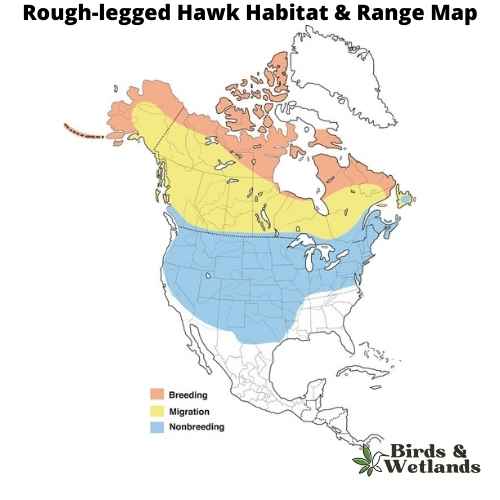
Rough-legged Hawk Sound
The Rough-legged Hawk is a large, raptor that is native to North America. It is also known as the American Rough-legged Hawk. Scientific Name: Buteo lagopus
The Rough-legged Hawk is a medium-sized hawk with a distinctive appearance, with dark brown feathers on its back and light brown feathers on its underside and broad thin wings. The hawk’s legs are also covered in dark feathers, which help to distinguish it from other species of hawk. The tail is barred with black and white. They have yellow eyes and dark feet.
Rough-legged Hawks hunt from above ground level, swooping down to catch its prey in its talons. When hunting for food, they prefer to eat small mammals such as squirrels and rabbits but will also eat birds if there aren’t any small mammals available. Although they eat a variety of small animals including birds, rodents, bats and reptiles, they rely heavily on fish for food during breeding season because it provides them with protein and calcium needed to produce eggs.
Sharp-shinned Hawk (Accipiter striatus)

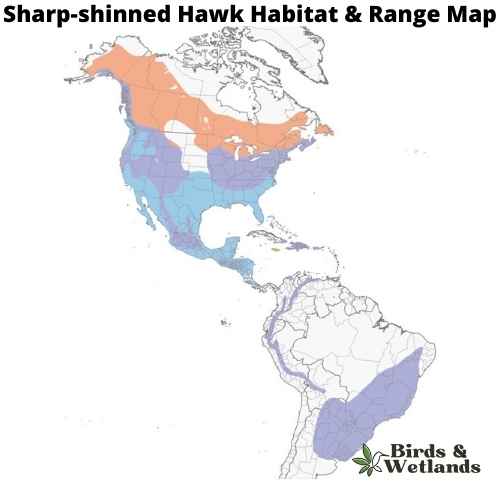
Listen:
The adult bird is brown on top and white underneath, with a dark brown band across its chest. It has short, rounded wings and a long tail that makes it look larger than it actually is. Adult sharp shinned hawks have black eyes, which are surrounded by white feathers. The female Sharp-shinned Hawk is browner than the male, who has darker brown markings on his back.
Sharp-shinned Hawks prefer open country for their habitat, including fields and meadows where they can hunt for mice and other small animals. They can be found throughout the United States but are most common in the east.
Sharp-shinned Hawks eat mostly small birds, such as sparrows and warblers, as well as small mammals such as mice and gophers. They catch prey by surprise using their incredible speed and agility, diving out of the sky at speeds up to 200 mph.
Sharp-shinned Hawks have an unusual hunting style for hawks—they prefer to catch their prey from perches above trees or telephone wires, rather than swooping down from above like most other hawks do and can often be seen hunting near bird feeders.
Northern Harrier (Circus hudsonius)

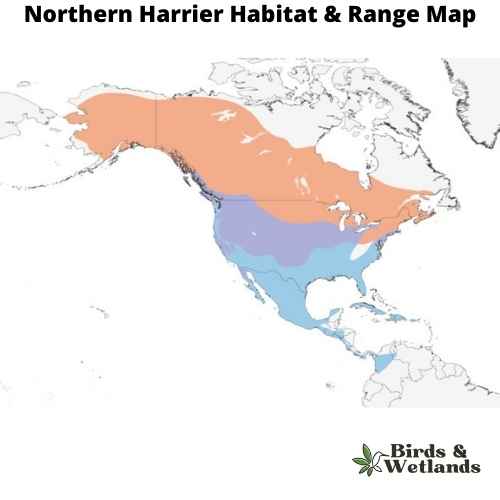
Listen:
The Northern Harrier is a medium-sized, slender hawk.
Adult birds are gray above, with pale bars on the wing feathers and white markings on the underwings and a white rump patch. The breast is barred with black and white, and the belly is streaked with brown.
They prefer open areas, such as grasslands and marshes, but can be found in almost any open habitat except dense woods.
Northern Harriers are opportunistic hunters that feed on small mammals such as mice, voles and rabbits as well as birds including quail, grouse and ducks. They hunt by flying low over open spaces such as fields or marshes.
Northern harrier nests on the ground in lowlands or hillsides near water bodies. It lays two to four eggs which hatch after 24 days of incubation by both parents. The chicks fledge after 30 days of hatching and remain dependent on their parents for another three weeks during which they learn how to fly.
Swainson’s Hawk (Buteo swainsoni)
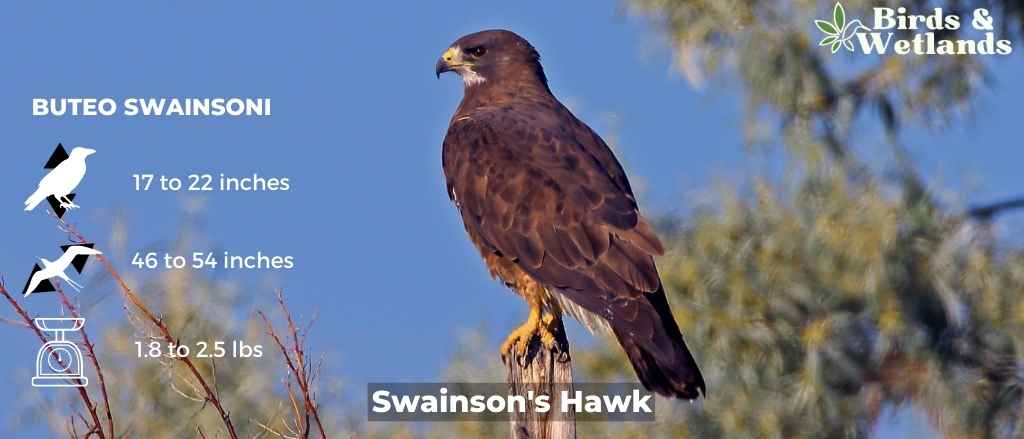
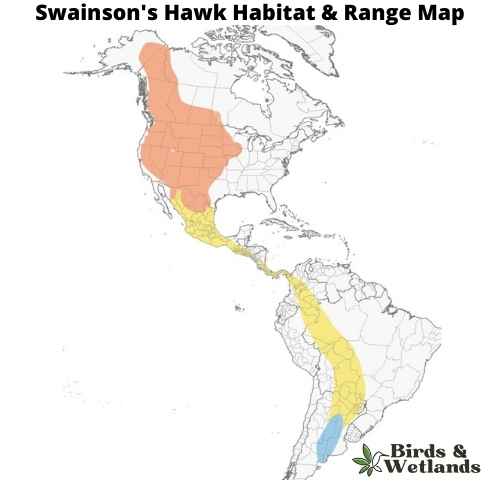
Listen: Swainson’s Hawk
Swainson’s Hawk is a medium-sized hawk that is found in North America and South America, Scientific Name: Buteo swainsoni.
The bird has a blue-gray plumage with a dark brown back, wings, and tail. It also has a white chest and belly. The beak and feet are black, but the eyes are yellow. They are often confused with Cooper’s Hawk because of similar coloring, but Swainson’s Hawks have wider tails and longer wings than their cousin species.
These birds eat small rodents such as gophers and mice. They also eat insects like grasshoppers and crickets during the summer months when they’re plentiful. They sometimes steal prey from other birds of prey such as Northern Harriers who hunt the same prey.
Swainson’s Hawks build nests on rocky cliffs near water sources where they can find food easily. They lay three to five eggs that hatch after about two months into fluffy brown baby hawks who leave the nest after about three weeks (or when they’re big enough).
Osprey (Pandion haliaetus)

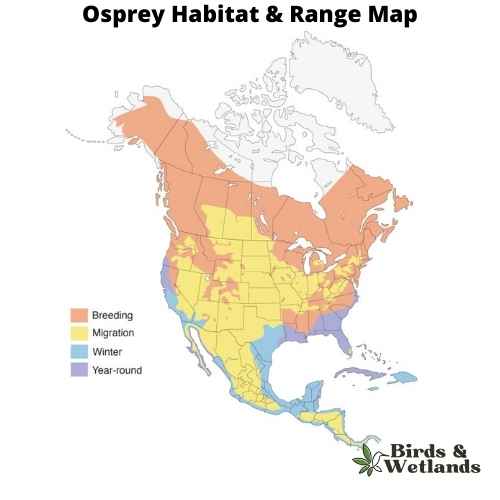
Osprey Sound
Scientific Name: Pandion haliaetus
Length: 50–66 cm (19+1⁄2–26 in)
Wingspan: 127–180 cm (50–71 in)
Weight: 0.9–2.1 kg (2 lb 0 oz – 4 lb 10 oz)
The Osprey, a fascinating bird of prey, is universally known for its exceptional hunting prowess and striking physical characteristics. Osprey are dark brown hawks on the upperparts, contrasting beautifully with the predominantly white underparts, and a distinctive dark band that stretches across the eyes towards the sides of its head.
Equipped with specialized talons and a reversible outer toe, the Osprey’s hunting strategy involves a spectacular plunge-dive into bodies of water, often emerging with a fish securely gripped in its claws.
Found on every continent except Antarctica, the Osprey is a cosmopolitan species favoring habitats near water bodies such as lakes, rivers, and coastal areas, reflecting its piscivorous diet. This bird has a diet almost exclusively of fish, making it a unique member of the raptor family and often referred to as the sea hawk or fish hawk. They locate their prey from the air, often hovering before plunging feet-first to capture a fish. When it comes to breeding, Ospreys are monogamous, often mating for life.
They construct large, bulky nests made of sticks, lined with softer materials, and prefer elevated or isolated areas such as treetops or artificial structures like utility poles. Both parents share the responsibility of incubating the eggs and rearing the chicks.
Where to Spot Hawks in Alaska
The Denali National Park offers a diverse habitat making it one of the best places to find the widest range of hawks in Alaska. With vast open landscapes, forests, and a myriad of ecosystems, this park serves as a natural hub for several hawk species including the Red-Tailed Hawk, Northern Harrier, and Rough-Legged Hawk.
Denali National Park: Offering a variety of habitats, this park is a haven for a multitude of hawk species.
Tongass National Forest: This temperate rainforest region, teeming with Northern Goshawks, also attracts other hawk species.
Arctic National Wildlife Refuge: A summer home to the Rough-Legged Hawk, this vast wilderness is also frequented by other hawk species.
Kenai Fjords National Park: Known for its breathtaking fjords, this park near the sea is a popular spot for Ospreys and other hawk species.
The enthralling exploration doesn’t end at the borders of Alaska. As you venture into the lush forests and open skies of Washington that includes a rich variety of hawks, is bound to captivate you. Similarly, the rugged terrain of Idaho is home to a wide array of hawks. And then there’s the expansive Oregon, where the majestic hawks effortlessly glide across the sky, adding a captivating charm to the state’s natural allure. Each state, with its unique terrain and climate, plays host to a distinctive mix of hawks, unfolding a continuous narrative of nature’s magnificent spectacle.
FAQs About Hawks in Alaska
What is the most common hawk in Alaska?
The Red-Tailed Hawk is considered the most common hawk in Alaska. Renowned for their broad, rounded wings and short, wide tails, these hawks can often be seen soaring in the sky or perched on tree branches, watching for prey.
What are the biggest & smallest hawks in Alaska?
Rough-legged Hawks , with a wingspan reaching up to 56 inches, ares one of the largest hawks in Alaska. On the other hand, the Sharp-shinned Hawk, measuring approximately 17 inches in length, is the smallest hawk in the state.
Do hawks breed in Alaska?
Yes, many species of hawks, including the Red-Tailed Hawk and Northern Goshawk, breeding range are in Alaska. They typically nest in large forests, tall trees or on cliffs, providing a safe haven for their eggs and young ones.
What do hawks eat in Alaska?
Most hawks in Alaska have a varied diet that includes small mammals, birds, and insects. Depending on the species, some opportunistic eaters like the Osprey also feed on fish, reflecting their adaptability to the rich Alaskan ecosystems and capture prey.
Can I hunt hawks in West Virginia?
No, it is illegal to hunt hawks in West Virginia, as well as in all other U.S. states. Hawks are protected under the Migratory Bird Treaty Act, which prohibits the capture, killing, or possession of these birds without a special permit.


